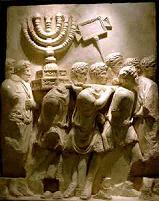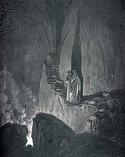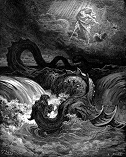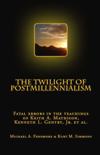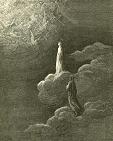New Jerusalem
Covenantal Habitation of the Saints
The images of the new heavens, new earth, and new Jerusalem in Revelation chapters twenty-one and twenty-two are believed by many to represent man’s heavenly home or the eternal state upon a new material creation. A variation in Preterist circles has it that these images indicate man is somehow mystically in “heaven now.” However, the better view is that the new Jerusalem symbolically describes the covenantal habitation of the saints under the gospel of Jesus Christ, and the new heavens and earth the world beneath Jesus' righteous dominion.
Literalist Conceptions
Most of us have encountered various literalist conceptions of Rev. 21 and 22 at some time or other. Indeed, it would be strange if we had not; the church abounds in them. If nothing else, we have probably been confronted with literalist notions of the new Jerusalem in a song or hymn, which mentions “streets of gold,” or heard the saying about St. Peter and the “pearly gates.” These and similar allusions are based upon the assumption that the imagery of Rev. 21 and 22 should be understood literally; that it describes things as they actually are or will be, rather than merely providing a symbolic description of spiritual truths. Typically, it is assumed that Revelation’s imagery of the new Jerusalem portrays heaven. Plummer’s interpretation is typical of this school:
“Having described the origin and progress of evil in the world,
the final overthrow of Satan and his adherents, and the judgment
when every man is rewarded according to his works, the seer now
completes the whole by portraying the eternal bliss of the
redeemed in heaven.”[1]
The weakness of this view is obvious: John specifically states that the new Jerusalem comes down out of heaven from God (Rev. 21:2, 10). If it comes down out of heaven, clearly the imagery cannot portray heaven itself.[2] This has caused others to see the imagery as referring to a material, new creation. Among the “church fathers” that saw these images as portraying a new, physical creation and city, Irenaeus thought there would be three levels of resurrection corresponding to individual worthiness:
“Then those who are deemed worthy of an abode in heaven shall go
there, others shall enjoy the delights of paradise, and others
shall possess the splendour of the city…For the first will be
taken up into the heavens, the second will dwell in paradise,
the last will inhabit the city.”[3]
Tertullian thought the images portrayed an earthly city during the “millennium”:
“But we do confess that a kingdom is promised to us upon the
earth, although before heaven, only in another state of
existence; inasmuch as it will be after the resurrection of a
thousand years in the divinely built city of Jerusalem.”[4]
Modern expositors falling into the error of a literalist interpretation of John’s vision include Mathison and Gentry:
“His elect people will inherit the eternal estate in
resurrected, physical bodies (Jno.
The assertion that man will live forever in
physical bodies in a material “new creation” betrays a
fundamental misunderstanding of God’s redemptive purpose.
It is the stuff of Jehovah’s Witnesses other cultic sects
inhabiting the fringes of Christendom.
It stems from Gentry’s belief in Postmillennialism, which
holds that God’s redemptive purpose culminates in a redeemed,
material creation.[6]
Never mind the many statements in scripture plainly
pointing to the fact that the saints inheritance is in heaven
(Phil.
Old Testament Origins of Revelation’s Imagery
Perhaps the simplest way to demonstrate the
proper interpretation of Revelation’s new heavens, new earth,
and new Jerusalem, is to examine how Old Testament writers
employed the imagery.
Study of the prophets shows that three themes dominated
their writings: 1) Prophecies of the coming captivity in
Understanding the poetic and typological
nature of the prophets’ writings is particularly important in
the study of eschatology where the language is couched in
apocalyptic imagery and symbolism derived from Old Testament
sources.
For example, the new heavens and earth of Revelation find their
source in the prophet Isaiah, who seems to have used the imagery
to describe the captivity’s return from
“Our adversaries have trodden down thy sanctuary…Thy holy cities
are a wilderness,
However, in Isa. 65, a remnant is promised:
“Thus saith the Lord, As the new wine in found in the cluster,
and one saith, Destroy it not; for a blessing is in it: so will
I do for my servants’ sakes, that I may not destroy them all.
And I will bring forth a seed out of Jacob, and out of
Judah an inheritor of my mountains: and mine elect shall inherit
it, and my servants shall dwell there.” (Isa. 65:8, 9)
The remnant would return and inherit a “new” heavens and earth. The old heavens and earth, marked by the nation's apostasy, bringing clouds and storms of destruction and wrath, would be replaced by a heavens and earth where God’s people would be blessed with peace and joy:
“For, behold, I create new heavens and a new earth: and the
former shall not be remembered, nor come to mind.
But be glad and rejoice for ever in that which I create:
for, behold, I create
The immediate application of this prophecy
may have looked to the return from captivity, but the poetic
nature of the language describing the new heaven and earth of
restored
What New Testament Writers Say
New Testament writers make clear that
"Tell me, ye that desire to be under the law, do ye not hear the law?
For it is written, that Abraham had two sons, the one by
a bondmaid, the other by a freewoman.
But he who was of the bondwoman was born after the flesh;
but he of the freewoman was by promise.
Which things are an allegory: for these are the two
covenants; the one from the mount Sinai, which gendereth to
bondage, which is Agar.
For this Agar is mount Sinai in
In this passage, Paul indicates that
The book of Hebrews was written during a
crisis of the last days when Christian Jews were under
persecution and pressured to forsake Christ and turn back to
Judaism. The
writer's main argument is to show that the law of Moses was
merely provisional and the remnant of its outward trappings
would shortly pass away. Christian Jews therefore should not be
deceived into thinking they could find security or salvation in
the temple cultus.
Much to the contrary, the on-going temple cultus was an implicit
denial of Christ's atoning sacrifice and sonship and marked the
Jews as his enemies to be destroyed. The writer quotes the
prophet Haggai and the "shaking" of the heavens and earth,
signifying the removal of thrones and dominions dominating the
pre-Christian world (Heb.
"For ye are not come unto the mount that might be touched, and
that burned with fire, nor unto blackness, and darkness, and
tempest, and the sound of a trumpet, and the voice of words;
which voice they that heard intreated that the word should not
be spoken to them any more…But ye are come unto mount Sion
[e.g., Zion], and unto the city of the living God, the heavenly
Jerusalem, and to an innumerable company of angels, to the
general assembly and church of the first born, which are written
in heaven, and to God the Judge of all, and to the spirits of
just men made perfect, and to Jesus the mediator of the new
covenant, , and to the blood of sprinkling that speaketh better
things that that of Abel. Heb. 12:18-24
Here, the writer compares the tangible
nature of things pertaining to the old covenant to the
intangible things of the new, indicating the superiority of the
latter. Notice that
the new covenant answers to
Timing of the New Jerusalem
The discussion above demonstrates the
substance of the new heavens and earth, and shows that it
answers the world-dominion of Christ.
What about the timing?
When would these things come to be?
Stephen, when tried for preaching Christ would come and
destroy the city and temple and change the customs embodied in
the Mosaic law (Acts 7:13, 14), cited the sixty-sixth chapter of
Isaiah as proof that he was preaching nothing that had not been
prophesied long before.
Before the Sanhedrin he quotes Isaiah, saying, “Heaven is
my throne, and earth is my footstool: what house will ye build
me? saith the Lord: or what is the place of my rest? Hath not my
hand made all these things?” (Acts 7:49, 50; cf. Isa. 66:1, 2).
Stephen thus indicated the imminent fulfillment of Isaiah’s
prophecy. The timing
of the new heavens and earth, therefore is not left in doubt,
but was clearly tied to the destruction of
First, Isaiah makes clear that national
"He
that killeth an ox is as if he slew a man; he that sacrificeth a
lamb, as if he cut off a dog’s neck; he that offereth an
oblation, as if he offered swine’s blood; he that burneth
incense, as if he blessed an idol.
Yea, they have chosen their own ways, and their soul
delighteth in their abominations.
I also will choose their delusions, and will bring their
fears upon them; because when I called, none did answer; when I
spake, they did not hear: but they did evil before mine eyes,
and chose that in which I delighted not. (Isa. 66:3, 4)
Next, he indicates the Jews would persecute their believing brethren and cast them out of the synagogue:
“Hear the word of the Lord, ye that tremble at his word; Your
brethren that hated you, that cast you out for my name’s sake,
said, Let the Lord be glorified: but he shall appear to your
joy, and they shall be ashamed. (Isa. 66:5)
Then, Isaiah prophesies the destruction of the city and temple alluded to by Stephen and foretold by Christ:
“A
voice of noise from the city, a voice from the temple, as voice
of the Lord that rendereth recompence to his enemies…For,
behold, the Lord will come with fire, and with his chariots like
a whirlwind, to render his anger with fury, and his rebuke with
flames of fire.” (Isa. 66:6, 15)
The prophet then states that those who
escaped the siege – Christians who obeyed Jesus’ warning to flee
when they saw the city compassed about with armies (Lk.
“And I will also take of them for priests and for Levites, saith
the Lord. For as the
new heavens and the new earth, which I make, shall remain before
me, saith the Lord, so shall your seed and your name remain.
And it shall come to pass, that from one new moon to
another, and from one Sabbath to another, shall all flesh come
and worship before me, saith the Lord.
And they shall go forth, and look upon the carcases of
the men that have transgressed against me: for their worm shall
not die, neither shall their fire be quenched; and they shall be
an abhorring unto all flesh.” (Isa. 66:21-24)
“All flesh” is equivalent to “every
creature” and “all nations” of the Great Commission (Matt.
28:18-20; Mk.
Heaven Now?
At the beginning of this article we indicated that, given the fulfilled nature of biblical eschatology, some Preterists feel they were somehow mystically in “heaven now.” Is there any validity to this interpretation?
No.
The heavenly city that God has prepared for his people
(Heb.
“Therefore we are always confident, knowing that, whilst we are
at home in the body, we are absent from the Lord: (for we walk
by faith not by sight:)
We are confident, I say, and willing rather to be absent
from the body, and to be present with the Lord.” (II Cor. 5:6-8)
“For I am in a strait betwixt two, having a desire to depart,
and to be with Christ; which is far better: Nevertheless to
abide in the flesh is more needful for you.” (Phill. 1:23, 24)
These passages make plain that there was a place Paul desired to go; there is not the least indication that he in any sense felt he had already gone to it or that it had, or ever would, come to him. The essential barrier to enjoyment of that place was his fleshly body. Not until the body was put off in death could his hope be realized.
Is there a sense in which saints this side of eternity share in that heavenly kingdom?
Yes, indeed there is. The new covenant is a
legal arrangement between two parties: God on the one side and
ransomed sinners on the other.
Under the new covenant, those who obey the gospel by
repentance and baptism are acquitted from sin and made sons of
God through Christ.
As sons, we have citizenship and inheritance in heaven (Eph.
Conclusion
The new Jerusalem describes the covenantal habitation of the saints, the New Testament church.
[1] A. Plummer, The Revelation of St. John the Divine, Pulpit Commentary (Hendrickson, Peabody, MS), Vol. XXII, p. 509.
[2] It comes down out of heaven, not because it was first “raptured” there, but because the New Testament originates with God; he is the architect of our salvation; the saints, though on earth, have citizenship in heaven.
[3] Irenaeus, Against Heresies, V, xxxvi, 1, 2; Ante-Nicene Fathers, Vol. I, p. 567.
[4] Tertullian,
Against Marcion,
[5] Kenneth L.
Gentry Jr., Christ's Resurrection and Ours, (
[6] “God seeks the redemption of the world as a created system of men and things...Christ’s labors will eventually effect the redemption of the created system of humanity and things.” Kenneth L. Gentry Jr, Three Views of the Millennium and Beyond (Zondervan, 1999), p. 43. Cf. Keith A. Mathison, Postmillennialism, An Eschatology of Hope (P&R Publishing, Phillipsburgn NJ, 1999), p. 107: “Christ’s atonement lays the foundation for the work of restoring all of man and all of creation.”
[7] Josephus, Wars, VI, iv, 5, 8.
[8] Josephus, Wars
of the Jews, VI, ix, 3.
This figure does not include those who perished
in foreign cities or died in battles throughout the rest
of
[9] Josephus, Wars of the Jews, V, xii, 3, 4.
To receive Kurt Simmons’ e-mail newsletter, The Sword & The Plow, click the Subscribe link:
All rights reserved.
